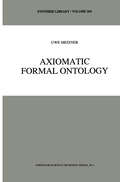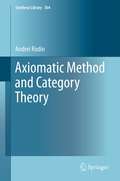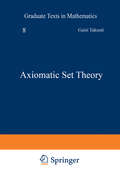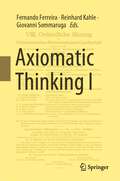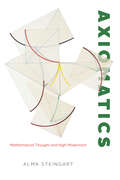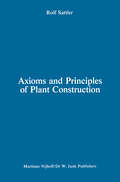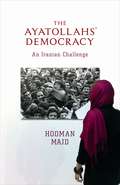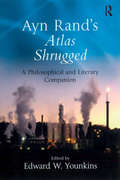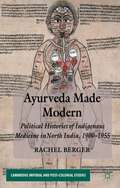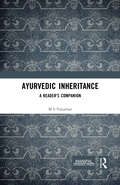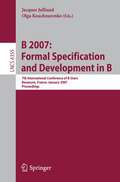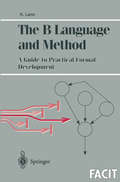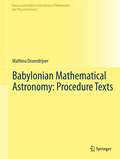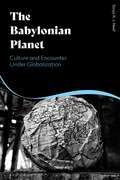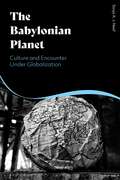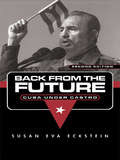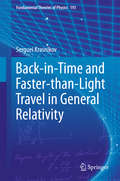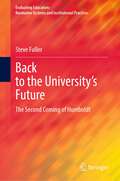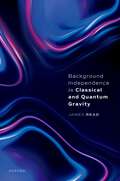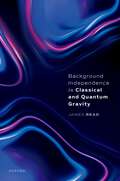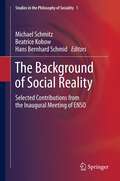- Table View
- List View
Axiomatic Formal Ontology (Synthese Library #264)
by Uwe MeixnerAxiomatic Formal Ontology is a fairly comprehensive systematic treatise on general metaphysics. The axiomatic method is applied throughout the book. Its main theme is the construction of a general non-set-theoretical theory of intensional entities. Other important matters discussed are the metaphysics of modality, the nature of actual existence, mereology and the taxonomy of entities.
Axiomatic Method and Category Theory (Synthese Library #364)
by Andrei RodinThis volume explores the many different meanings of the notion of the axiomatic method, offering an insightful historical and philosophical discussion about how these notions changed over the millennia. The author, a well-known philosopher and historian of mathematics, first examines Euclid, who is considered the father of the axiomatic method, before moving onto Hilbert and Lawvere. He then presents a deep textual analysis of each writer and describes how their ideas are different and even how their ideas progressed over time. Next, the book explores category theory and details how it has revolutionized the notion of the axiomatic method. It considers the question of identity/equality in mathematics as well as examines the received theories of mathematical structuralism. In the end, Rodin presents a hypothetical New Axiomatic Method, which establishes closer relationships between mathematics and physics.Lawvere's axiomatization of topos theory and Voevodsky's axiomatization of higher homotopy theory exemplify a new way of axiomatic theory building, which goes beyond the classical Hilbert-style Axiomatic Method. The new notion of Axiomatic Method that emerges in categorical logic opens new possibilities for using this method in physics and other natural sciences.This volume offers readers a coherent look at the past, present and anticipated future of the Axiomatic Method.
Axiomatic Set Theory (Graduate Texts in Mathematics #8)
by G. Takeuti W.M. ZaringThis text deals with three basic techniques for constructing models of Zermelo-Fraenkel set theory: relative constructibility, Cohen's forcing, and Scott-Solovay's method of Boolean valued models. Our main concern will be the development of a unified theory that encompasses these techniques in one comprehensive framework. Consequently we will focus on certain funda mental and intrinsic relations between these methods of model construction. Extensive applications will not be treated here. This text is a continuation of our book, "I ntroduction to Axiomatic Set Theory," Springer-Verlag, 1971; indeed the two texts were originally planned as a single volume. The content of this volume is essentially that of a course taught by the first author at the University of Illinois in the spring of 1969. From the first author's lectures, a first draft was prepared by Klaus Gloede with the assistance of Donald Pelletier and the second author. This draft was then rcvised by the first author assisted by Hisao Tanaka. The introductory material was prepared by the second author who was also responsible for the general style of exposition throughout the text. We have inc1uded in the introductory material al1 the results from Boolean algebra and topology that we need. When notation from our first volume is introduced, it is accompanied with a deflnition, usually in a footnote. Consequently a reader who is familiar with elementary set theory will find this text quite self-contained.
Axiomatic Thinking I
by Fernando Ferreira Reinhard Kahle Giovanni SommarugaIn this two-volume compilation of articles, leading researchers reevaluate the success of Hilbert's axiomatic method, which not only laid the foundations for our understanding of modern mathematics, but also found applications in physics, computer science and elsewhere.The title takes its name from David Hilbert's seminal talk Axiomatisches Denken, given at a meeting of the Swiss Mathematical Society in Zurich in 1917. This marked the beginning of Hilbert's return to his foundational studies, which ultimately resulted in the establishment of proof theory as a new branch in the emerging field of mathematical logic. Hilbert also used the opportunity to bring Paul Bernays back to Göttingen as his main collaborator in foundational studies in the years to come.The contributions are addressed to mathematical and philosophical logicians, but also to philosophers of science as well as physicists and computer scientists with an interest in foundations.Chapter 8 is available open access under a Creative Commons Attribution 4.0 International License via link.springer.com.
Axiomatics: Mathematical Thought and High Modernism
by Alma SteingartThe first history of postwar mathematics, offering a new interpretation of the rise of abstraction and axiomatics in the twentieth century. Why did abstraction dominate American art, social science, and natural science in the mid-twentieth century? Why, despite opposition, did abstraction and theoretical knowledge flourish across a diverse set of intellectual pursuits during the Cold War? In recovering the centrality of abstraction across a range of modernist projects in the United States, Alma Steingart brings mathematics back into the conversation about midcentury American intellectual thought. The expansion of mathematics in the aftermath of World War II, she demonstrates, was characterized by two opposing tendencies: research in pure mathematics became increasingly abstract and rarified, while research in applied mathematics and mathematical applications grew in prominence as new fields like operations research and game theory brought mathematical knowledge to bear on more domains of knowledge. Both were predicated on the same abstractionist conception of mathematics and were rooted in the same approach: modern axiomatics. For American mathematicians, the humanities and the sciences did not compete with one another, but instead were two complementary sides of the same epistemological commitment. Steingart further reveals how this mathematical epistemology influenced the sciences and humanities, particularly the postwar social sciences. As mathematics changed, so did the meaning of mathematization. Axiomatics focuses on American mathematicians during a transformative time, following a series of controversies among mathematicians about the nature of mathematics as a field of study and as a body of knowledge. The ensuing debates offer a window onto the postwar development of mathematics band Cold War epistemology writ large. As Steingart’s history ably demonstrates, mathematics is the social activity in which styles of truth—here, abstraction—become synonymous with ways of knowing.
Axiomatics: Mathematical Thought and High Modernism
by Alma SteingartThe first history of postwar mathematics, offering a new interpretation of the rise of abstraction and axiomatics in the twentieth century. Why did abstraction dominate American art, social science, and natural science in the mid-twentieth century? Why, despite opposition, did abstraction and theoretical knowledge flourish across a diverse set of intellectual pursuits during the Cold War? In recovering the centrality of abstraction across a range of modernist projects in the United States, Alma Steingart brings mathematics back into the conversation about midcentury American intellectual thought. The expansion of mathematics in the aftermath of World War II, she demonstrates, was characterized by two opposing tendencies: research in pure mathematics became increasingly abstract and rarified, while research in applied mathematics and mathematical applications grew in prominence as new fields like operations research and game theory brought mathematical knowledge to bear on more domains of knowledge. Both were predicated on the same abstractionist conception of mathematics and were rooted in the same approach: modern axiomatics. For American mathematicians, the humanities and the sciences did not compete with one another, but instead were two complementary sides of the same epistemological commitment. Steingart further reveals how this mathematical epistemology influenced the sciences and humanities, particularly the postwar social sciences. As mathematics changed, so did the meaning of mathematization. Axiomatics focuses on American mathematicians during a transformative time, following a series of controversies among mathematicians about the nature of mathematics as a field of study and as a body of knowledge. The ensuing debates offer a window onto the postwar development of mathematics band Cold War epistemology writ large. As Steingart’s history ably demonstrates, mathematics is the social activity in which styles of truth—here, abstraction—become synonymous with ways of knowing.
Axioms and Principles of Plant Construction: Proceedings of a symposium held at the International Botanical Congress, Sydney, Australia, August 1981
by R. SattlerThis volume presents the proceedings of a symposium which I organised for the Developmental Section of the Xlllth International Botanical Congress at Sydney, Australia on August 26, 1981. The paper by Professor T. Sachs, which was received too late for inclusion into the symposium at Sydney, was added to these proceedings because of its direct relevancy and importance. The aim of the symposium was to state in an explicit and comprehensive fashion the most basic axioms and principles of plant morphology and morphogenesis. An awareness of these axioms and principles is of paramount importance since they form. the foundations as well as the goal of structural developmental botany. Both teaching and research are predicated on them. The Introduction by the editor briefly examines the meaning of the concepts "axiom", "principle", and "plant construction". The comprehensive paper by Dr. G. Cusset, a unique historical overview, explicates 37 principles of 5 major conceptual systems and many subsystems. The extensive analysis includes a genealogy of ideas and ways of thinking of major authors ranging from philosophers and naturalists of antiquity to recent investigators of plant form and structure. The bibliography of Dr. Cusset I s paper comprises ca. 700 references. The contribution by Professor H. Mohr focusses on modern principles of morphogenesis and provides a penetrating analysis of scientific explanation in developmental biology. The universal principles (laws) described in this paper apply to all living systems, whereas the more specific principles are limited to plants or only higher plants. Professor T.
The Ayatollahs' Democracy: An Iranian Challenge
by Hooman Majd"There are several peculiar features about writing any detailed account of the recent political events in Persia which make necessary some slight explanation. The first point is that Persian political affairs, fraught as they are with misfortune and misery for millions of innocent people, are conducted very much as a well-staged drama - I have heard some critics say, as an opéra bouffe." William Morgan Shuster, "The Strangling of Persia" , 1912So Hooman Majd introduces his story of Iran, with its volatile politics, jostling leaders, global ambitions, and enormous implications for world peace. What does it mean for the world if "Green" represents not a revolution but a civil rights movement, pushing the country toward a particular brand of "Islamic democracy"? And how will Iran's diversity of political positions, so often sidelined in news reporting, ultimately resolve itself? With witty, candid, and stylishly-intelligent reporting, Hooman Majd introduces top-level politicians and clerics alongside regular Iranians, including Jewish community leaders. A personal, candid tour of the political and social landscape in Iran, The Ayatollahs' Democracy is a powerful dispatch from a country at a historic turning point.
Ayn Rand's Atlas Shrugged: A Philosophical and Literary Companion
by Edward W. YounkinsSince its publication in 1957 Atlas Shrugged, the philosophical and artistic climax of Ayn Rand's novels, has never been out of print and has received enormous critical attention becoming one of the most influential books ever published, impacting on a variety of disciplines including philosophy, literature, economics, business, and political science among others. More than a great novel, Atlas Shrugged is an abstract conceptual, and symbolic work that expounds a radical philosophy, presenting a view of man and man's relationship to existence and manifesting the essentials of an entire philosophical system - metaphysics, epistemology, politics and ethics. Celebrating the fiftieth year of Atlas Shrugged's publication, this companion is an exploration of this monumental work of literature. Contributions have been specially commissioned from a diversity of eminent scholars who admire and have been influenced by the book, the included essays analyzing the novel's integrating elements of theme, plot and characterization from many perspectives and from various levels of meaning.
Ayn Rand's Atlas Shrugged: A Philosophical and Literary Companion
by Edward W. YounkinsSince its publication in 1957 Atlas Shrugged, the philosophical and artistic climax of Ayn Rand's novels, has never been out of print and has received enormous critical attention becoming one of the most influential books ever published, impacting on a variety of disciplines including philosophy, literature, economics, business, and political science among others. More than a great novel, Atlas Shrugged is an abstract conceptual, and symbolic work that expounds a radical philosophy, presenting a view of man and man's relationship to existence and manifesting the essentials of an entire philosophical system - metaphysics, epistemology, politics and ethics. Celebrating the fiftieth year of Atlas Shrugged's publication, this companion is an exploration of this monumental work of literature. Contributions have been specially commissioned from a diversity of eminent scholars who admire and have been influenced by the book, the included essays analyzing the novel's integrating elements of theme, plot and characterization from many perspectives and from various levels of meaning.
Ayurveda Made Modern: Political Histories of Indigenous Medicine in North India, 1900-1955 (Cambridge Imperial and Post-Colonial Studies)
by R. BergerThis book explores the ways in which Ayurveda, the oldest medical tradition of the Indian subcontinent, was transformed from a composite of 'ancient' medical knowledge into a 'modern' medical system, suited to the demands posed by apparatuses of health developed in late colonial India.
Ayurvedic Inheritance: A Reader's Companion
by M S ValiathanThis book is a companion to Āyurvedic studies. It discusses the history and evolution of Ayurveda, its philosophy, and its practical uses in everyday life—from medicine to mental wellbeing. It harks back to the traditional Indian concept of four aspects of lifelong learning. These were instruction by the teacher, individual effort, learning from companions and lastly, wisdom gathered over a lifetime. Print edition not for sale in South Asia (India, Sri Lanka, Nepal, Bangladesh, Pakistan and Bhutan)
Ayurvedic Inheritance: A Reader's Companion
by M S ValiathanThis book is a companion to Āyurvedic studies. It discusses the history and evolution of Ayurveda, its philosophy, and its practical uses in everyday life—from medicine to mental wellbeing. It harks back to the traditional Indian concept of four aspects of lifelong learning. These were instruction by the teacher, individual effort, learning from companions and lastly, wisdom gathered over a lifetime. Print edition not for sale in South Asia (India, Sri Lanka, Nepal, Bangladesh, Pakistan and Bhutan)
B 2007: 7th International Conference of B Users, Besancon, France, January 7-19, 2007, Proceedings (Lecture Notes in Computer Science #4355)
by Jacques Julliand Olga KouchnarenkoThis book constitutes the refereed proceedings of the 7th International Conference of B Users, B 2007, held in Besançon, France, January 2007. Coverage in this volume includes industrial applications and case studies using B, integration of model-based specification methods in the software development lifecycle, derivation of hardware-software architecture from model-based specifications, and validating requirements through formal models.
The B Language and Method: A Guide to Practical Formal Development (Formal Approaches to Computing and Information Technology (FACIT))
by Kevin LanoB is one of the few formal methods which has robust, commercially-available tool support for the entire development lifecycle from specification through to code generation. This volume provides a comprehensive introduction to the B Abstract Machine Notation, and to how it can be used to support formal specification and development of high integrity systems. A strong emphasis is placed on the use of B in the context of existing software development methods, including object-oriented analysis and design. The text includes a large number of worked examples, graduated exercises in B AMN specification and development (all of which have been class-tested), two extended case studies of the development process, and an appendix of proof techniques suitable for B. Based on material which has been used to teach B at postgraduate and undergraduate level, this volume will provide invaluable reading a wide range of people, including students, project technical managers and workers, and researchers with an interest in methods integration and B semantics.
Babylonian Mathematical Astronomy: Procedure Texts (Sources and Studies in the History of Mathematics and Physical Sciences)
by Mathieu OssendrijverThis book contains new translations and a new analysis of the procedure texts of Babylonian mathematical astronomy, the earliest known form of mathematical astronomy of the ancient world. The translations are based on a modern approach incorporating recent insights from Assyriology and translation science. The work contains updated and expanded interpretations of the astronomical algorithms and investigations of previously ignored linguistic, mathematical and other aspects of the procedure texts. Special attention is paid to issues of mathematical representation and over 100 photos of cuneiform tablets dating from 350-50 BCE are presented.In 2-3 years, the author intends to continue his study of Babylonian mathematical astronomy with a new publication which will contain new editions and reconstructions of approx. 250 tabular texts and a new philological, astronomical and mathematical analysis of these texts. Tabular texts are end products of Babylonian math astronomy, computed with algorithms that are formulated in the present volume, Procedure Texts.
The Babylonian Planet: Culture and Encounter Under Globalization
by Sonja NeefWhat is astro-culture? In The Babylonian Planet it is unfolded as an aesthetic, an idea, a field of study, a position, and a practice. It helps to engineer the shift from a world view that is segregated to one that is integrated – from global to planetary; from distance to intimacy and where closeness and cosmic distance live side-by-side. In this tour de force, Sonja Neef takes her cue from Edouard Glissant's vision of multilingualism and reignites the myth of the Tower of Babel to anticipate new forms of cultural encounter. For her, Babel is an organic construction site at which she fuses theoretical analysis and case studies of artists, writers and thinkers like William Kentridge, Orhan Pamuk and Immanuel Kant. Her skilful interrogations then allow her to paint a portrait of art and culture that abolishes the horizon as a barrier to vision and reclaims it as a place of contact and relation. By combining the Babylonian concept of the encounter and the planetary concept of the whole-earth, Neef creates a space – an astro-culture – in which she can examine topics as varied as language, translation, media, modernity, migration and the moon. In doing so, she instigates a renewed cultural understanding receptive to the kinder forms of cultural encounter and globalisation she hopes will come.
The Babylonian Planet: Culture and Encounter Under Globalization
by Sonja NeefWhat is astro-culture? In The Babylonian Planet it is unfolded as an aesthetic, an idea, a field of study, a position, and a practice. It helps to engineer the shift from a world view that is segregated to one that is integrated – from global to planetary; from distance to intimacy and where closeness and cosmic distance live side-by-side. In this tour de force, Sonja Neef takes her cue from Edouard Glissant's vision of multilingualism and reignites the myth of the Tower of Babel to anticipate new forms of cultural encounter. For her, Babel is an organic construction site at which she fuses theoretical analysis and case studies of artists, writers and thinkers like William Kentridge, Orhan Pamuk and Immanuel Kant. Her skilful interrogations then allow her to paint a portrait of art and culture that abolishes the horizon as a barrier to vision and reclaims it as a place of contact and relation. By combining the Babylonian concept of the encounter and the planetary concept of the whole-earth, Neef creates a space – an astro-culture – in which she can examine topics as varied as language, translation, media, modernity, migration and the moon. In doing so, she instigates a renewed cultural understanding receptive to the kinder forms of cultural encounter and globalisation she hopes will come.
Back From the Future: Cuba Under Castro
by Susan Eva EcksteinThis book has long been regarded as the definitive history of Castro's communist regime, beginning in 1959 through the 1990s. This updated, second edition contains a new epilogue by the author that covers the last decade, including such newsworthy events as the Elian Gonzalez controversy, the growing immigrant community of Cuban-Americans in Florida, the role of Cuban-Americans in the 2000 presidential election, the withering U.S. sales embargo and the inevitable transition of power now that Castro is in his mid-70s.
Back From the Future: Cuba Under Castro
by Susan Eva EcksteinThis book has long been regarded as the definitive history of Castro's communist regime, beginning in 1959 through the 1990s. This updated, second edition contains a new epilogue by the author that covers the last decade, including such newsworthy events as the Elian Gonzalez controversy, the growing immigrant community of Cuban-Americans in Florida, the role of Cuban-Americans in the 2000 presidential election, the withering U.S. sales embargo and the inevitable transition of power now that Castro is in his mid-70s.
Back-in-Time and Faster-than-Light Travel in General Relativity (Fundamental Theories of Physics #193)
by Serguei KrasnikovFor the past 20 years causality violations and superluminal motion have been the object of intensive study as physical and geometrical phenomena. This book compiles the results of its author and also reviews other work in the field. In particular, the following popular questions are addressed: Is causality protected by quantum divergence at the relevant Cauchy horizon? How much "exotic matter" would it take to create a time machine or a warp drive? What is the difference between a "discovered" time machine and a created one? Why does a time traveler fail to kill their grandfather? How should we define the speed of gravity and what is its magnitude?
Back to the University's Future: The Second Coming of Humboldt (Evaluating Education: Normative Systems and Institutional Practices)
by Steve FullerThis volume addresses the central question facing the future of higher education around the world, whether and why universities need to exist at all. This book accepts the question’s premise: It is not clear that the university is any longer needed as an institution -- that is, unless its defenders recover what had made the university the revolutionary institution that over the past two centuries has not only defined the shape of modern systematic inquiry but also the distinctiveness of the societies that have housed them. In short, what is required is a reanimation of the spirit of Wilhelm von Humboldt for our times; hence the book's title and subtitle. Humboldt was responsible for relaunching the university as the vanguard institution of 'Enlightenment' to which we continue to pay lip service – and sometimes not much more than that. Admittedly, the task of relaunching Humboldt today is made difficult because many of the concrete achievements associated with the Humboldtian university – not least academic disciplines and nation-states – are increasingly seen as problematic if not obsolete. However, the global reach of the Humboldtian vision in its 19th century and 20th century heyday offers hope that it may be recovered in the 21st century. The book focuses on the performative character of the academic vocation, what Humboldt memorably characterized as the 'unity of research and teaching' in the same person, a role model for students and society at large. The book's seven chapters develop this theme in a historically and philosophically nuanced way in terms of the Humboldtian vision of knowledge, sense of free expression and critical judgement, and commitment to translation and publicity.
Background Independence in Classical and Quantum Gravity
by Dr James ReadIt is often claimed that Einstein's magnum opus—-his 1915 theory of General Relativity—-is distinguished from other theories of space and time in virtue of its background independence. It's also often claimed that background independence is an essential feature of any quantum theory of gravity. But are these claims true? This book aspires to offer definitive answers to both of these questions, by (a) charting the space of possible definitions of background independence, and (b) applying said definitions to various classical and quantum theories of gravity. The outcome, in brief, is as follows: General Relativity is not unique by virtue of its background independence (and, indeed, fails to be background independent on some popular definitions); moreover, the situation in the case of quantum theories of gravity is delicate, because (i) there are viable such theories which (by some accounts, at least) fail to be background independent, but also (ii) theories (e.g. perturbative string theory) which have often been dismissed for (allegedly) being background dependent in fact, on many accounts, are better classified as background independent. In giving these answers in rigorous detail, this book seeks to elevate the standards and generality of future discussions of background independence in the foundations of spacetime theories.
Background Independence in Classical and Quantum Gravity
by Dr James ReadIt is often claimed that Einstein's magnum opus—-his 1915 theory of General Relativity—-is distinguished from other theories of space and time in virtue of its background independence. It's also often claimed that background independence is an essential feature of any quantum theory of gravity. But are these claims true? This book aspires to offer definitive answers to both of these questions, by (a) charting the space of possible definitions of background independence, and (b) applying said definitions to various classical and quantum theories of gravity. The outcome, in brief, is as follows: General Relativity is not unique by virtue of its background independence (and, indeed, fails to be background independent on some popular definitions); moreover, the situation in the case of quantum theories of gravity is delicate, because (i) there are viable such theories which (by some accounts, at least) fail to be background independent, but also (ii) theories (e.g. perturbative string theory) which have often been dismissed for (allegedly) being background dependent in fact, on many accounts, are better classified as background independent. In giving these answers in rigorous detail, this book seeks to elevate the standards and generality of future discussions of background independence in the foundations of spacetime theories.
The Background of Social Reality: Selected Contributions from the Inaugural Meeting of ENSO (Studies in the Philosophy of Sociality #1)
by Michael Schmitz, Beatrice Kobow and Hans Bernhard SchmidThis volume aims at giving the reader an overview over the most recent theoretical and methodological findings in a new and rapidly evolving area of current theory of society: social ontology. This book brings together philosophical, sociological and psychological approaches and advances the theory towards a solution of contemporary problems of society, such as the integration of cultures, the nature of constitutive rules, and the actions of institutional actors. It focuses on the question of the background of action in society and illuminates one of the most controversial, cross-disciplinary questions of the field while providing insight into the ontological structure of groups as agents. This volume offers an interesting and important contribution to the debate as it does well in bridging the gap between the analytical and the continental tradition in social philosophy. In addition, this volume expands the reach and depth of the philosophy of sociality by relating it to philosophical ideas from the late 19th and early 20th centuries and to key thinkers such as Husserl, Heidegger, and Bourdieu. The contributors include internationally renowned scholars as well as a highly selected set of younger scholars whose work is at the cutting edge of their field. Scholarly, yet accessible, this book is an essential resource for researchers across the social sciences.
